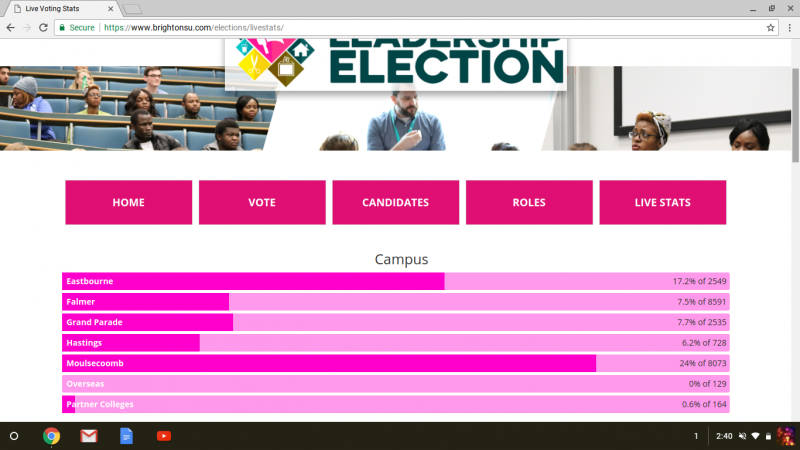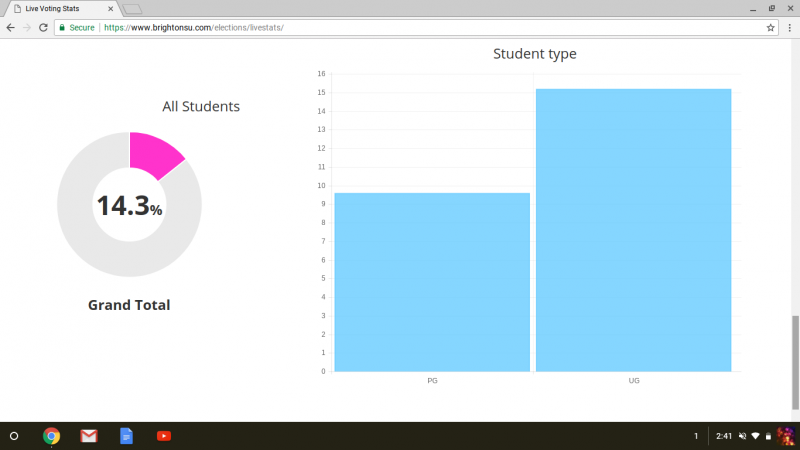BSU electorate
One of the additional #EdublogsClub prompts is sharing a statistic and writing about it. I want to share a few screenshots with you after having a discussion with a member of staff on Grand Parade campus last spring. He said that Grand Parade students vote in an equal percentage to other campuses. I did not agree so I tried to obtain some statistics from the student union. Unfortunately, due to limited server space they were not able to access statistics from previous years.
In my post about the by-election 2016, I noted that 369 students voted and in the most recent by-election I noted that there were 321 votes in total (NB/ the term votes is used not voters, so it is possible that less than 321 people voted). Since my post, the student union found some more statistics for me.

by-election statistics
For those unable to read my small screenshot. 0.5% of the electorate voted in the last by-election. Of course this number could be rounded up or rounded down. If 0.5% is accurate then approximately 112 people voted. The worst turn out was from overseas and partner colleges – nobody voted (though this is possibly inaccurate because, for example, modular education students may be studying overseas but their school is classified as being on Falmer campus). 0.2% of Grand Parade (the art school and part of the humanities school) voted. The best turn out was from Hastings with 0.8%.
Last summer, after failing to get statistics from the student union for the previous elections, I decided to screenshot the results for the most recent election (which is the election which the current leadership team got elected in). I contacted the student union as there appeared to be a glitch in the breakdown of the school departments (so I excluded that data from my screenshots). These screenshots are from August.

statistics – breakdown by campus

statistics – breakdown by halls and partner colleges

screenshot – total voters and breakdown by undergraduate/post-graduate
The first thing you’ll probably notice is that the bars are not to scale. But I’m looking at the statistics.
The second thing you’ll notice is that there is a greater turn out from the Moulsecoomb and Eastbourne campuses. Interestingly, many (if not all) of the elected leadership team study on these campuses. For my experience on all university campuses, I prefer Moulsecoomb and Eastbourne as they seem to have better social places which may contribute to the sense of community there. That’s just my opinion though. During the election campaigns I saw more posters on these campuses and more of the staff seemed to be aware and/or supportive of the election.
| Grand Parade is an interesting campus. It’s primarily arts and humanities. The students are definitely not politically apathetic, so I’m not sure why the voting is low. I have a few ideas worth exploring:
Grand Parade is more autonomous Grand Parade is more radical Grand Parade is busy and can’t be bothered |
You’ll also notice partner colleges have a low turn out. Partner colleges are colleges than have a higher education provision that is accredited by the University of Brighton. I can only speculate about the low turn out. As someone who worked in a partner college before coming to University of Brighton I had the task of enrolling the HE students (right before they had to enrol online with University of Brighton). At no point did I meet any University of Brighton Student Union staff on the partner college campus. And as an University of Brighton Alumni Association employee I attempted to hand a goody bag to one of my ex-colleagues – he replied that he didn’t go to University of Brighton. There was a clear seperation in his mind between the university and partner college.
Of course, my theories are based on personal experiences so if you’re a partner college student who feels connected to the University of Brighton Student Union I’d love to hear from you. Additionally, if you’re a Grand Parade student with opinions on the lower turn out than other campuses I’d like to hear from you too.